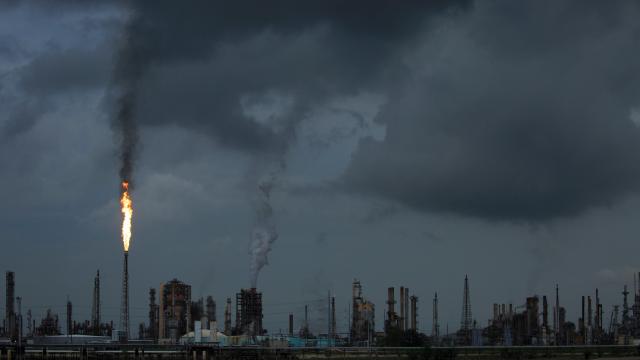The oil and gas industry may be seriously undercounting its greenhouse gas emissions. A technique used to burn off methane during production may be getting rid of less of the greenhouse gas than previously thought, a new study finds — which could mean that emissions from flaring could be as much as five times higher than previous estimates.
A study published Thursday in Science looks at the efficiency of a process known as flaring in three of the U.S.’s largest oil and gas producing basins — the Eagle Ford and Permian basins in Texas and the Bakken basin in North Dakota — which account for about 80% of the oil and gas produced in the U.S. The study finds that while the industry claims flaring gets rid of some 98% of methane emissions, the number is actually closer to 91%. While the numerical difference may seem small, it actually represents as much as a 10% increase in total U.S. methane emissions.
Methane is much more short-lived in the atmosphere than carbon dioxide, but packs a powerful punch while it’s up there: it’s about 80 times more potent than CO2 over a 20-year period. Methane emissions have risen so rapidly worldwide, and we have so little time to turn the tide on climate change, that the Intergovernmental Panel on Climate Change said last year that curbing methane emissions in the short term will be crucial to stopping runaway warming. The oil and gas industry is one of the world’s biggest sources of human-caused methane emissions — and increasing amounts of studies show that the industry is seriously undercounting its impact when it comes to this particular greenhouse gas.
Oil and gas production creates a lot of excess gas that can’t be captured for sale or use; if left untouched, this excess gas, which is loaded with methane, can escape into the atmosphere and cause a lot of warming in the short term. The process of flaring — burning off the gas — is used by the industry to get rid of that methane, with fossil fuel producers claiming that flaring gets rid of 98% of emissions from that extra gas.
Turns out, that assumption was based on some seriously outdated data. The numbers that were used to calculate that 98% were based on just a couple studies from the 1980s — none of which used actual observations in the field.
“Most flare studies have been conducted in laboratory or testing facility settings such that sensitivities to various parameters (e.g. flare tip design, fuel composition, etc.) can be assessed under controlled conditions,” Genevieve Plant, the study’s lead author, told Earther over email. “There have been limited studies of ‘real-world’ flares such that it was not known if these controlled experiments captured flare performance under field operating conditions and over the lifetime of a flare.”
To get a more accurate picture of how effective flaring might actually be to get rid of methane, Plant and her colleagues conducted observations in the field by flying downwind of flares in an aircraft equipped with methane sensors. They then combined those measurements with ground surveys of unlit flares. In crunching the numbers, the researchers found that in addition to questionable efficacy from lit flares, unlit flares — which just spew gas directly into the atmosphere — were much more prevalent than previously thought, helping to drive down the efficacy percentage.
Methane is considered a low-hanging fruit of climate policy: there are concrete changes polluting industries like oil and gas can make to cut emissions, and quickly. The oil and gas industry has long made a show of saying it is acting on methane emissions, while simultaneously working to block policies that would actually make reductions happen. This study represents yet another opportunity for the industry to right its methane ship; it remains to be seen if producers will act on this new piece of information, or just let polluting business continue as usual.
“Flares in the U.S. represent a larger portion of the methane oil and gas budget than we previously thought,” Plant said. “Addressing flares, through reducing flare gas volumes and/or taking measures to ensure flares operate properly, would have a large and previously unrecognised climate benefit.”
